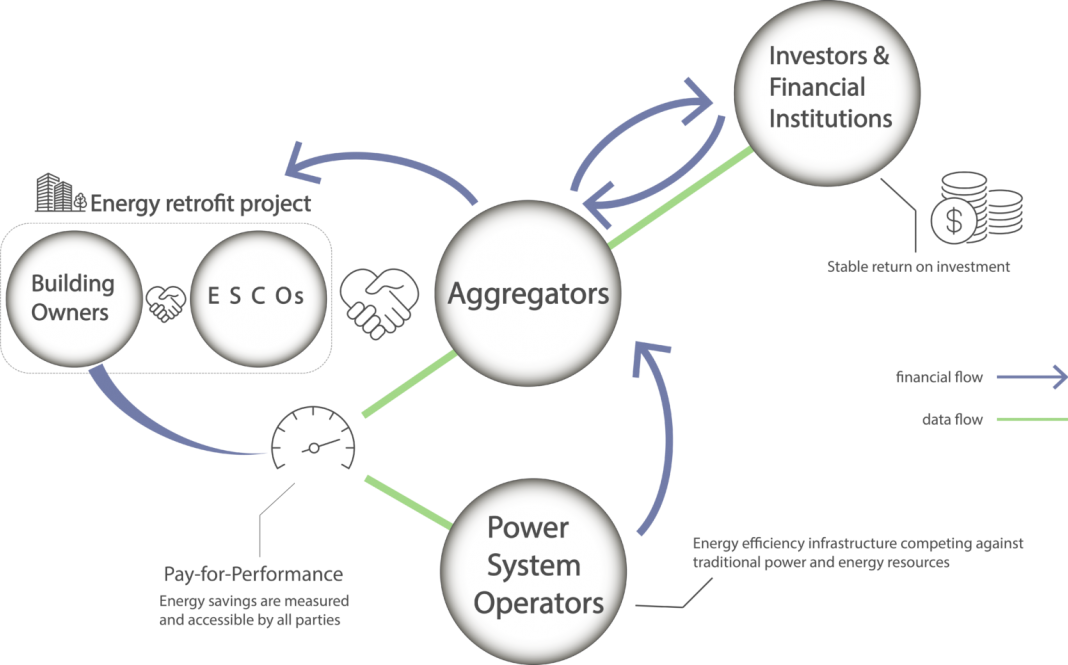Filippos Anagnostopoulos, Senior Associate for the Institute for European Energy and Climate Policy (IEECP), discusses the role of Pay-for-Performance schemes to increase the scale and effectiveness of energy efficiency financing
The principle of Pay-for-Performance schemes, or P4P, is that payments for energy efficiency should be made according to the performance of implemented measures. Using advanced measurement and verification (M&V) methods, the energy savings resulting from applied measures become a measurable quantity – essentially: an energy efficiency meter.
The P4P approach applies to many levels of established policies and measures as a transformative enabler for the financing of energy efficiency projects. Based on experience from the US, and as it will be further explained, P4P allows to improve current subsidy schemes, aggregate buildings into larger portfolios to access financing, and make use of demand-side resources as a service to the power grid.
Pay-for-Performance schemes facilitate financial flows for building retrofits
Primarily, P4P improves existing energy efficiency programmes that follow the deemed (pre-assumed) energy savings approach, which remunerates contractors based on installed energy efficiency measures, but not on their performance. Public entities funding retrofit programmes have very little control over the quality of works and are unable to track real energy savings. With the P4P approach, the risk of underperformance is on the private sector which is responsible for implementing appropriate measures, while public authorities can have access to accurate energy-saving data. Under this approach, one-off payments are replaced with periodic payments that are proportional to the metered energy savings.
Secondly, aggregation enables large-scale investments and novel business models to access diverse building types, including smaller residential properties, and tap into their potential for energy savings. P4P and advanced M&V allows to aggregate individual projects into larger portfolios to enable large-scale investments in energy efficiency projects with an improved risk management strategy. The PG&E residential P4P program in California offers a good example. Following a competitive procedure, PG&E selects several aggregators, which engage with residential homes to deliver EE upgrades. Using advanced M&V of a third party (Recurve), the energy savings from these portfolios of buildings are measured on an ongoing basis to calculate their performance, according to which, PG&E rewards aggregators based on their bid of $/kWh saved.
Thirdly, P4P enables the power system to recognise energy efficiency as a demand-side energy resource by quantifying and rewarding energy demand reductions, instead of extending capacity to meet demand, an option often termed “non-wires alternatives”. An example is the Home Energy Savings Program, a residential P4P programme administered by NYSERDA and the National Grid in the state of New York. It targets large portfolios of one-to-four-family homes to achieve large-scale energy savings and compensate aggregators accordingly. The utility makes use of the energy demand reduction resulting from the implemented measures as a demand-side grid resource, and a deferral of investments for grid upgrades. The SENSEI project has proposed a methodology to quantify the value of building energy efficiency projects as a power grid resource using the same process and the same tools that power system operators use for capacity adequacy studies.
The power system could utilise the metered energy demand reduction of P4P schemes as a demand-side resource
Regulators are essential to set up P4P- enabled programmes, which are inherently constructed top-down. The SENSEI project analyzed 12 P4P programmes, mostly from North America, that have shown potential in decreasing system costs, deferring investments, and lowering emissions. Existing programmes have been mostly set up in the context of Energy Efficiency Obligations (EEOSs) for power system actors and target large commercial buildings, while residential buildings have also appeared promising.
The European Commission, being aware of the potential of P4P schemes, stated in its 2020 Renovation Wave communication that “Member States can […] scale up market incentives such as […], pay-per-performance public support schemes […] to attract private intermediaries and aggregators”. This commitment was re-iterated in May 2022 in the context of REpowerEU, at the EU Save Energy communication, stating that “the Commission will examine possible additional measures to trigger further private investments, e.g. through […] pay-for- performance schemes”.
National competent authorities are invited to explore P4P programmes, supported by the Recovery and Resilience Facility
The EU Member States can enable new business models for energy efficiency based on P4P supported by the provisions in REPowerEU and the Recovery and Resilience Facility. What is now needed is national pilots, following inclusive stakeholder dialogues and partnerships between regulatory bodies, power system operators, manufacturers, ESCOs, digitalisation solution providers and consumers. To achieve the right market configurations national stakeholders could adjust existing mechanisms in a stepwise approach:
- Commitment: Recognise energy efficiency as an energy resource at a high level (regulatory, legislative, TSO/DSO, Utilities) and secure commitments to pilot energy efficiency programmes based on pay-for-performance and metered savings.
- Facilitation: Designate a competent managing authority (energy agency or a government entity) to oversee and support the co-design and execution of pilots, to define minimum energy performance standards, and to set enabling rules and the right infrastructure.
- Advanced M&V: Develop or adopt an open and transparent methodology for metered savings using measurement and verification methods such as CalTRACK or eensight to increase accuracy and transparency.
- Procurement: Issue tenders for energy efficiency projects that adopt the pay-for-performance approach and a compensation structure based on metered savings. Provide favorable conditions to secure involvement, including by ensuring predictability through guarantees.
- Evaluate and Repeat: Gather insights and know-how from the first pilots, conduct capacity building activities to strengthen the role of market actors, and repeat piloting with improved approaches and refinements (e.g. on payment structures).
The SENSEI project will be running until the end of 2022, offering a closing window of opportunity to relevant national and local competent author- ities (ministries, energy agencies, regulators, utilities, TSOs and DSOs) to receive valuable directions on exploring the potential of Pay-for-Performance schemes. Interested organisations can reach out to the SENSEI project coordinator Filippos Anagnostopoulos at filippos@ieecp.org.

This work is licensed under Creative Commons Attribution-NonCommercial-NoDerivatives 4.0 International.


